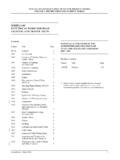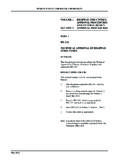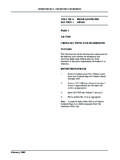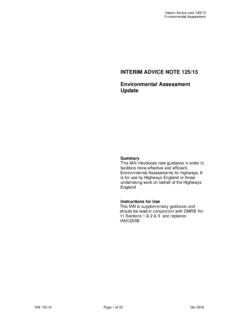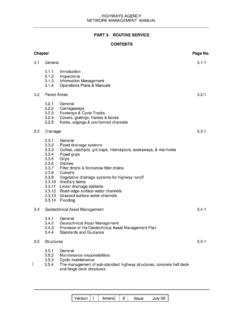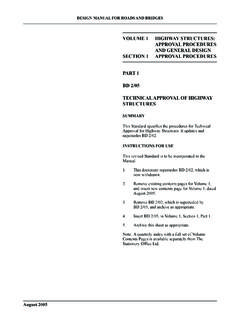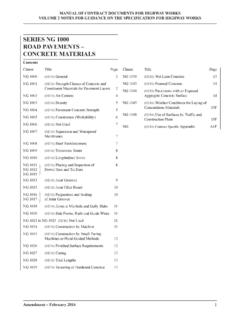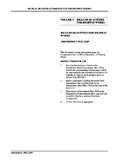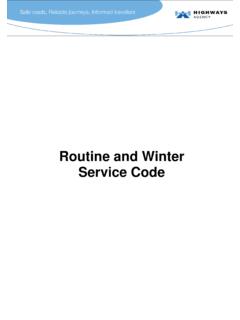Transcription of INTERIM ADVICE NOTE 44/05 (IAN 44/05) (REVISION 4 OF …
1 INTERIM ADVICE NOTE 44/05 (REVISION 4 OF IAN 44) IAN 44/05 (Revision 4) Aug 2005 INTERIM ADVICE NOTE 44/05 (IAN 44/05 ) (REVISION 4 OF IAN 44) INTERIM REQUIREMENTS FOR ROAD restraint systems (VEHICLE & PEDESTRIAN) SUMMARY This INTERIM ADVICE Note provides: Information and guidance on changes to the provision and procurement process in relation to Road restraint systems (Vehicle & Pedestrian) to ensure compliance with BS EN 1317-1 to 3 and DD ENV 1317-4:2002. Information on how the Non-Proprietary Safety Barrier Systems (NPSBS) are to be used. INSTRUCTIONS FOR USE This Revision 4 of IAN 44/05 supersedes Amendment No. 1 of IAN 44/05 issued on 3 February 2005. For reference purposes, the previous versions of this IAN 44 have been: i) IAN 44/02 (Original) dated August 2002 ii) IAN 44/02 (Revision 1) dated August 2003 iii) IAN 44/02 (Revision 2) dated June 2004 iv) IAN 44/05 (Revision 3) dated 20th January 2005 v) IAN 44/05 Amendment No 1 dated 3rd Feb 2005 INTERIM ADVICE NOTE 44/05 (REVISION 4 OF IAN 44) IAN 44/05 (Revision 4) Aug 2005 INTERIM REQUIREMENTS FOR ROAD restraint systems (VEHICLE & PEDESTRIAN) CONTENTS Section Description Page No.
2 1 Introduction 1 2 Withdrawal / Amendment of Standards 3 3 Implementation 3 4 Formal Application to Use IRRRS 4 5 Formal Application to Use Proprietary Vehicle restraint systems 4 6 Incorporation into Contract Documents 5 7 Copies of IRRRS (Revision 1) and NPSBS (Revision 1) 5 8 Contact for Technical Queries 6 Appendix 1 List of Documents to be Withdrawn / Amended Appendix 2 Vehicle Parapets Appendix 3 (Not used) Appendix 4 Road Restraint system Acceptance Procedure - Flowcharts Appendix 5 General Guidance on Incorporating INTERIM Requirements for Road Vehicle restraint systems (IRRRS) into Contracts INTERIM ADVICE NOTE 44/05 (REVISION 4 OF IAN 44) IAN 44/05 (Revision 4) 1 Aug 2005 INTERIM REQUIREMENTS FOR ROAD restraint systems (VEHICLE & PEDESTRIAN) 1 Introduction This ADVICE Note provides guidance on changes to the provision and procurement process in relation to Road restraint systems (RRS) to ensure compliance with European Commission requirements for RRS as set out in BS EN 1317-1 to 3 and DD ENV 1317-4:2002, and in prEN1317-5 & -6 which are currently available as drafts.
3 The introduction of the various parts of BS EN 1317 and DD ENV 1317-4:2002 ensures a consistent performance based Standard is used in the testing, manufacture and supply of RRS throughout the European Economic Area (EEA) and will thereby remove any barriers to trade . This update to the Advise Note also provides guidance and information on the Approved EN 1317 Road restraint systems and the use of the Non Proprietary Safety Barrier Systems (NPSBS). The INTERIM Requirements for Road restraint systems (Vehicle and Pedestrian) (IRRRS) (Revision 1) has been produced to ensure compliance with the various parts of BS EN 1317 and DD ENV 1317-4:2002. It includes criteria for determining the need for permanent and temporary safety barriers, vehicle parapets, terminals and transitions/connections between different types of safety barriers and vehicle parapets, crash cushions, pedestrian parapets, pedestrian guardrails, arrester beds and anti-glare screens.
4 The technical and safety ADVICE for vehicle restraints systems have been reviewed and updated and is contained within the IRRRS (Revision 1) document dated December 2004; The main updates to IRRRS (Revision 1) were; Protection of lighting columns in verges Containment Classes for End Terminals Protection at verge embankments Reduction of gaps in verge safety barriers Passive safety ADVICE BS EN 1317-1 to -3 and DD ENV 1317-4:2002 are performance based Standards which require Design Organisations to specify [in Appendix 4/1 (MCHW 2)], for a particular location, the following performance criteria: (i) Containment Performance Class and Working Width Class for safety barriers and transitions; (ii) Containment Performance Class and Working Width Class for vehicle parapets; (iii) Performance Class and Lateral Displacement Zone Class for terminals; and (iv) Performance Level , Velocity Class , Lateral Displacement Zone Class and type of crash cushion [redirective (R) or non-redirective (NR)] for crash cushions.
5 Design Organisations must NOT specify the use of any specific type/design of safety barrier or vehicle parapet etc., but instead requirements must be expressed in performance criteria terms stated above. Contractors will be allowed to formally propose for the HA s review / acceptance any safety barrier, vehicle parapet (except concrete vehicle parapets) or crash cushion that complies with the relevant parts of BS EN 1317 and, for terminals and transitions/connections, with DD ENV 1317-4:2002, and the Containment Performance Class , Performance Class , Performance Level , Working Width Class , Velocity Class and Lateral Displacement Zone Class criteria specified in Appendix 4/1 (MCHW 2) of the Contract. INTERIM ADVICE NOTE 44/05 (REVISION 4 OF IAN 44) IAN 44/05 (Revision 4) 2 Aug 2005 Vehicle restraint systems proposed by Contractors must be subject to acceptance prior to use on a scheme specific basis. The acceptance process is detailed in Section 5 and also in the flowcharts at Appendices to inclusive.
6 The Highways Agency have previously allowed the use of the Non-Proprietary Safety Barrier Systems (NPSBS) on the Trunk Road Network through the departure from standard submission process. The reason for this was because there were insufficient approved EN 1317 compliant Proprietary road restraint systems to fulfil the needs of the Highway Agency. Recently, however, the number of approved EN1317 compliant road restraint systems have increased to such an extent that the use of the NPSBS is now no longer required. Therefore the NPSBS dated June 2002 and the NPSBS (Revision 1) dated July 2005 are now withdrawn for new Contracts on Highways Agency Roads. Consequently, the NPSBS (Revision 1) is only to be used for reference purposes, maintenance inspections, minor maintenance replacement works, and repair works for accident damage. The Containment Performance Classes and Working Widths stated in the NPSBS (Revision 1) are still deemed to be appropriate for existing safety barriers including like for like repairs.
7 A number of barriers detailed in the NPSBS have recently been retested in accordance with the requirements of BS EN 1317 2 and are shown to comply. These vehicle restraint systems have been included in the Highways Agency s Approved Road Restraint system list and a copy of this list can be obtained by emailing: It should be noted that it is the intention of the Highways Agency to hand over the rights to these products to Industry by the end of this financial year 2005/2006, with the view that they are taken on, re-named and promoted as proprietary systems. These will then replace the NPSBS in the Approved Road Restraint system List. However, in the INTERIM , the Highways Agency will continue to provide information and guidance on these products. For new Contracts, the Working Width Class s given in the Highways Agency s Approved Road Restraint system List must be used rather than the values given in the NPSBS (Revision 1). This is because the latest dynamic testing to BS EN 1317-2 has shown that the Working Widths of some of these safety barriers have increased from those detailed in the NPSBS (Revision 1) Data Sheets.
8 The primary reason for this is that modern vehicles are more rigid and do not absorb as much impact energy as the older vehicles that were used in pre-EN 1317 tests. Consequently the safety barriers re-tested deflected more, resulting in larger Working Widths. Therefore the Working Width Classes shown on the Approved List must be used if Contractors are proposing to use these safety barriers on future Contracts. For those Highways Agency s Schemes that have commenced on site, the Working Widths stated in the NPSBS (Revision 1) Data Sheets will be acceptable without the need for a Departure from Standard submission to the Overseeing Organisation. For those schemes in the preparation stage that have not yet commenced on site, the Road restraint systems in the Approved Road restraints Systems List MUST be used. For those schemes that have not commenced on site and have already proposed to use the NPSBS then the working width of the proposed safety barriers must be re-examined to determine if there is an increased risk to road users.
9 Specific hazards that will need close examination are where Road restraint systems are located adjacent to: Bridge piers Lighting columns, Large signposts Or other objects in close proximity to the system . INTERIM ADVICE NOTE 44/05 (REVISION 4 OF IAN 44) IAN 44/05 (Revision 4) 3 Aug 2005 If a system from the Approved List cannot be accommodated then a Departure from Standard (DfS) submission is required. The Transitions/Connections detailed in the NPSBS (Revision 1) are deemed acceptable for use on the Highways Agency s road network until amendments to DD ENV 1317-4:2002 are completed, at which time further testing of the Transitions/Connections may be required. A Departure from Standard submission is not required for the use of transitions /connections detailed in the NPSBS (Revision 1). The Terminals listed in the NPSBS (Revision 1) are deemed acceptable for use on the Highways Agency s road network until amendments to DD ENV 1317-4:2002.
10 These can be used where the speed limit is not greater than 50mph. These Terminals will also be accepted for use on the departure end of safety barriers on dual carriageway roads where the speed limit is greater than 50mph. A Departure from Standard submission is not required for the use of Terminals detailed in the NPSBS (Revision 1). 2 Withdrawal / Amendment of Standards For those works defined in Section 3, Paragraph below, the DMRB Standards, ADVICE notes and IAN s are either amended or withdrawn and replaced as stated in Appendix 1. For all Road Restraint system work outside the scope of Section 3, Paragraph then those Standards and ADVICE notes etc. referred to as being either amended or withdrawn in Paragraph must still apply. 3 Implementation The IRRRS (Revision 1) (dated December 2004) document is to be used on new contracts as follows (further guidance is given in the flowchart in Appendix below) (i) All new highway work (including Targeted programme of Improvement Schemes (TPI s); (ii) All Maintenance Renewal Schemes where it has been identified during the pre design survey process that the Road Restraint system (s) need to be replaced, such as Road restraint systems that have reached the end of their useful life and are detrimental to safety, and those Road restraint systems not meeting current requirements for Containment.)
